Global Recycled HDPE Pellets Market - Comprehensive Data-Driven Market Analysis & Strategic Outlook
The global recycled HDPE pellets market will be an icon of change in the plastic world, revolutionizing the way industries think about sustainability and material recycling. Going beyond the traditional recycling, the market will open up a new vision where plastics that are discarded no longer become a setback but rather turn into precious raw materials. The recycled high-density polyethylene pellets will be the backbone for companies looking to cut costs while remaining eco-friendly. With greener options being implemented by production industries across the globe, the future of production will see a stronger inclination towards materials that do not lose quality at the cost of environmental integrity.
- The global recycled HDPE pellets market valued at approximately USD 2453.7 Million in 2025, growing at a CAGR of around 9.2% through 2032, with potential to exceed USD 4545.1 Million.
- Reprocessed HDPE Pellets account for nearly 24.2% market revenues, driving innovation and expanding applications through intense research.
- Key trends driving growth: Growing emphasis on circular economy and sustainable packaging solutions., Rising government regulations promoting plastic recycling and waste reduction.
- Opportunities include Expanding applications of recycled HDPE in construction and automotive sectors.
- Key insight: The market is set to grow exponentially in value over the next decade, highlighting significant growth opportunities.
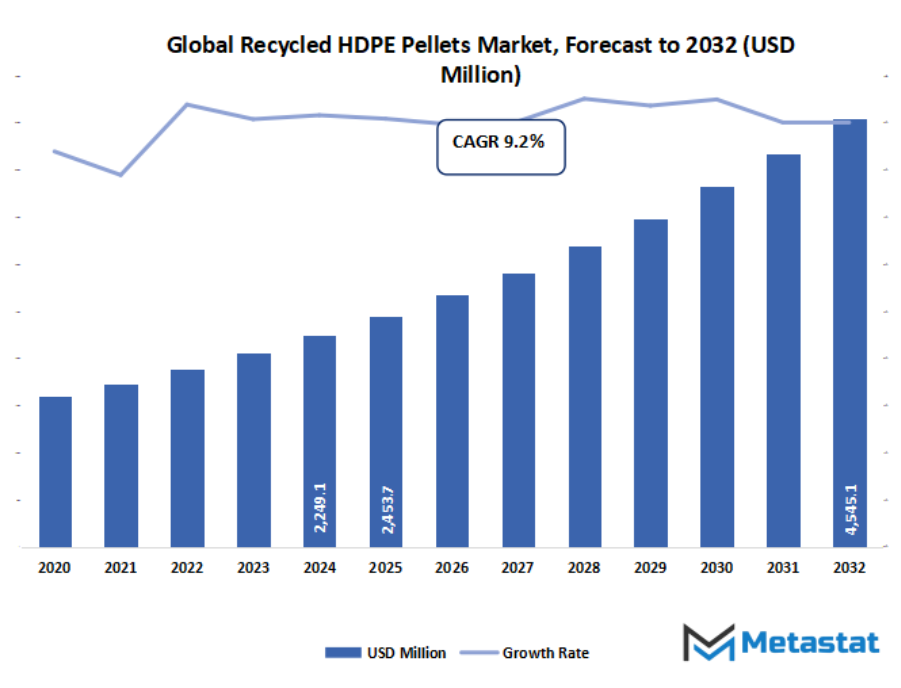
The demand for recycled HDPE pellets is not going to be limited to the traditional applications, thanks to the global focus on sustainability. However, market saturation might inhibit their uptake. What if recycling technology breakthroughs would reshape the cost and quality to be so that they are new opportunities for both manufacturers and end-users? And as global environmental regulations become more stringent, could supply chain disruptions or raw material shortages affect this market's growth negatively?
The sector will look beyond mere collection and recycling of plastic rubbish. The use of recycled pellets as raw materials in the production process will be the most ranked strategy among all given due to the higher quality of such pellets and lower costs compared to virgin resins. In this respect, the purity, and quality of the new plastics produced from recycled materials will be matching those of virgin plastic, thus widening their application in packaging, automotive, construction, and consumer goods industries. Supply chains of companies will be more and more dependent on recycled pellets in the future years, thanks to the policy support, innovations, and consumers' increased consciousness about sustainable production being the main drivers.
Market Segmentation Analysis
The global recycled HDPE pellets market is mainly classified based on Product Type, Form, Application, End-Use Industry.
By Product Type is further segmented into:
- Reprocessed HDPE Pellets The attention to eco-friendly production is one of the factors that will drive the global recycled HDPE pellets market to witness a rise in demand for reprocessed HDPE pellets. Such pellets will be extracted from municipal and industrial waste and will make the industries reap savings while cutting the usage of virgin materials, etc. The industries will use this raw material in order to be eco-friendly and to meet the recycling requirements.
- Natural HDPE Pellets Natural HDPE pellets' purity and their ability to produce products of high quality will make them the most valued in the market. These will be utilized in a broad spectrum of applications that encompass both product strength and aesthetics for packaging and consumer products. The increasing emphasis on environmental concerns and eco-friendly materials will also contribute to their usage in industry.
- Colored HDPE Pellets Colored HDPE pellets will be the most sought-after product in the market because they minimize the cost of tinting products by allowing manufacturers to add their colors during the manufacturing process. In addition, the segments for packaging, containers, and auto parts will remain strong drivers of future demand since they will allow both design flexibility and ecological sustainability.
- Blended HDPE Pellets Blended HDPE pellets will see moderate yet continuous uptake in the global recycled HDPE pellets market due to their versatility and applicability for multiple uses. Blended HDPE pellets will be formulated by blending recycled with virgin HDPE, thereby resulting in a high quality and environmentally friendly product.
By Form the market is divided into:
- Extrusion Grades Extrusion-grade pellets will remain significant in the global recycled HDPE pellets market. They will be employed for sheets, films, and pipes because of their process stability and flexibility. Their demand will increase in the future as companies move towards recycled materials for large-scale extrusion applications.
- Injection Molding Grades Injection molding grades in the market will be worth for manufacturing robust and accurate components. Such pellets will be used in containers, automotive components, and packaging caps. Light weight and recyclability trend of molded products will lead to sustainable growth in the segment.
- Blow Molding Grades Blow molding grades will continue to be important in the market to produce bottles, containers, and tanks. Their strength and resistance to cracking will position them well for storage applications. With improved recycling infrastructure, production of blow-molded products from recycled pellets will increase.
- Film Grades Pellets of film-grade will be of growing significance in the global recycled HDPE pellets market because of increasing demand for green films and wraps. These pellets will be used in applications such as in agriculture, packaging, and industrial films. Increasing processing technology will improve film quality and clarity with recycled products.
By Application the market is further divided into:
- Plastic Bottles Plastic bottle production will have a significant share in the global recycled HDPE pellets market. The recycling of pellets will substitute virgin polymers to create environmentally friendly bottles. As the world tries to cut down on plastic waste, future production lines will use recycled HDPE for drink, cleaning, and personal care bottles.
- Containers The use of HDPE-based containers with recycled pellets is anticipated to be the primary factor driving the market as the companies turn towards green packaging. Besides, they will make difficult and chemical resistant the containers for industries as well as for households. Recycling activities are on the rise, thus, the application of HDPE-based containers in supply chains will be further increased across the globe.
- Automotive Parts The market will mainly be supported by recycling of plastics. The reason is that the demand for lightweight parts goes up along with the automotive industry. Recycled HDPE is going to be used to create even more diverse parts such as tanks, fenders, and also components that go in-between the engine and the passenger compartment. Sustainability along with less expensive ways of manufacturing will be considered in the future by the car makers who will mix recycled plastic into their products.
- Construction Materials The manufacturing of construction materials will make the market bigger through the usage of recycled pellets. The melting of the pellets will be done for producing pipes, fittings, and composite panels as part of the green building movement. In order to provide long-lasting and eco-friendly infrastructures, the construction industry will hopefully, turn to recycled HDPE.
- Consumer Goods More and more recycled pellets will be used in the production of consumer goods in the global recycled HDPE pellets market. The toy, furniture, and home goods making industries will have to incorporate recycled HDPE into their production streams owing to the green regulations. This practice will appeal to the eco-friendly consumers who are on the lookout for sustainable lifestyle products.
By End-Use Industry the global recycled HDPE pellets market is divided as:
- Packaging Packaging will continue to be a major end-use segment of the global recycled HDPE pellets market. The demand for light, recyclable materials will push the packaging sector to incorporate recycled HDPE in production of bottles, films, and containers. This will follow the path of international sustainability goals and circular economy practices.
- Textiles There will be a greater interest in the market from the textile industry as it is searching for the innovative materials for fabrics and fibers. The recycled HDPE will be made into threads and non-woven fabrics that will last a long time. The process will be environmentally friendly and still provide the textile industry with the efficient performance it needs.
- Consumer Goods The market will see an increase in the consumer product segment as more brands commit to environmentally friendly products. Recycled HDPE will be used for a multitude of daily items while maintaining durability with a lower carbon footprint. The market segment will be fortified due to the rising emphasis on eco-friendly consumer goods.
- Automotive The automotive industry will be the primary contributor to the market growth. Car makers will adopt recycled HDPE on a larger scale to produce components that are both light-weight and recyclable. Therefore, the trend will not only allow one to meet the sustainability goals but also lead to better fuel efficiency, thus turning recycled pellets into the material of the future for automotive production.
- Construction The construction sector will be a major contributor to the global recycled HDPE pellets market by going for the use of recycled materials in its infrastructural projects. The recycled HDPE will soon be the raw material for products that are permanent like pipes, panels, and fittings. The rising green building activities and government intervention will together speed up its overall adoption.
|
Forecast Period |
2025-2032 |
|
Market Size in 2025 |
$2453.7 Million |
|
Market Size by 2032 |
$4545.1 Million |
|
Growth Rate from 2025 to 2032 |
9.2% |
|
Base Year |
2024 |
|
Regions Covered |
North America, Europe, Asia-Pacific, South America, Middle East & Africa |
Geographic Dynamics
Based on geography, the global recycled HDPE pellets market is divided into North America, Europe, Asia-Pacific, South America, and Middle East & Africa. North America is further divided in the U.S., Canada, and Mexico, whereas Europe consists of the UK, Germany, France, Italy, and Rest of Europe. Asia-Pacific is segmented into India, China, Japan, South Korea, and Rest of Asia-Pacific. The South America region includes Brazil, Argentina, and the Rest of South America, while the Middle East & Africa is categorized into GCC Countries, Egypt, South Africa, and Rest of Middle East & Africa.
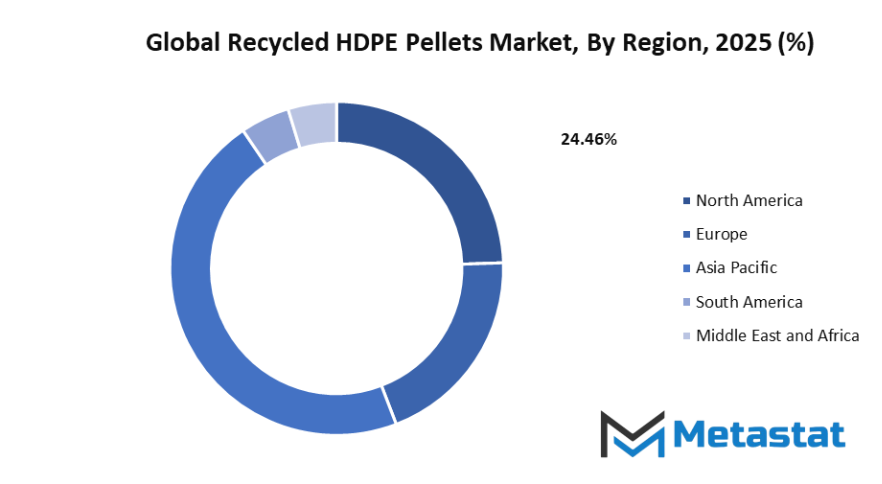
Competitive Landscape & Strategic Insights
Metastat Insight report on the global recycled HDPE pellets market depicts a market that is gradually expanding, driven by the sustainability goals, technological advancements and the growing demand for eco-friendly materials. High-density polyethylene (HDPE) has the status of one of the most recycled plastic substances worldwide and upgrading it to recycled pellets has been a major contributor to the circular economy. These pellets have a wide range of applications in different sectors such as packaging, construction materials and even automotive parts. The trend of less plastic being disposed of and the rising acceptance of environmentally friendly manufacturing processes will always be in the forefront affecting the reactions and innovations of the industry in this market.
The industry is composed of a mixture of the well-established global companies and the fast growing regional companies, which make it look very competitive and diverse. The Veolia, Borealis AG, Clean Tech Inc., and KraussMaffei Group, etc., have been the leaders in the industry for decades and are well known for their extensive recycling infrastructure and complex processing technologies. In a similar manner, Recycling Technologies Ltd., Envision Plastics, and MBA Polymers Inc. have slowly but surely got a foothold in the global market with their creative recycling technologies. The efforts of the two groups have not only increased the rates of recovering materials but have also been a factor in the making of high-quality and high-performance recycled HDPE pellets which find use in numerous industrial and consumer applications.
Among the new regional players, ALBA Group, MYGroup (GB) Limited, and Viridor, significant progress has also been made in developing recycling capacities and implementing successful waste collection systems. Their presence in the market exemplifies not only the growing demand for but also the increasing investment in eco-solutions in different regions. Companies are striving for better production, better pellets, and strong supply chains that can serve the packaging and manufacturing sectors, whose demand is constantly rising.
The participation of companies like Rebornplas Composites CO., LTD, Centriforce, and Visy indicates how local knowledge and innovation are still making the overall market framework more robust. Most of these companies are investing in new recycling facilities, embracing cutting-edge sorting technologies, and working with government and private agencies to make plastic waste more manageable. All this interaction among global leaders and local recyclers is making the market landscape more balanced and more resistant.
As sustainability is rapidly becoming the focus of industries globally, the global recycled HDPE pellets market will further transform with increased endorsement from environmental regulations, business resolutions, and customer consciousness. The combined thrust of the industry towards decreasing plastic waste and enhancing recycling effectiveness will not only serve the environment but will also provide long-term prospects for innovation and economic development.
Market Risks & Opportunities
Restraints & Challenges:
Varying quality and contamination in recycled materials: The global recycled HDPE pellets market will persist with challenges of inconsistent quality standards in recycled plastic. Contamination at the collection or processing stage will reduce material efficiency and impose restrictions on industries that need consistency in raw materials. Improved segregation and purification units will be necessary to accommodate increasing performance requirements in the future.
Inadequate recycling infrastructure and high processing cost: A major drawback that will confront the market is the limited number of recycling facilities and the considerable expense incurred in the process of pelletizing waste for reuse. The recycling process in many regions is still hampered by a lack of collection networks, old equipment, and high costs. Hence, the government support and the application of new technologies will be a requirement for keeping the cost-effective situation.
Opportunities:
The increasing application of recycled HDPE in the building and car manufacturing sectors: The global recycled HDPE pellets market will be getting an increasing amount of demand as more and more automobile and construction industries are going to be shifting to sustainable materials. Recycled HDPE will not only be used in future projects for making pipes and panels but also as an auto part because it is tough and saves money. The sector's potential will be enhanced even more through constant innovation and design improvement.
Forecast & Future Outlook
- Short-Term (1–2 Years): Recovery from COVID-19 disruptions with renewed testing demand as healthcare providers emphasize metabolic risk monitoring.
- Mid-Term (3–5 Years): Greater automation and multiplex assay adoption improve throughput and cost efficiency, increasing clinical adoption.
- Long-Term (6–10 Years): Potential integration into routine metabolic screening programs globally, supported by replacement of conventional tests with advanced biomarker panels.
Market size is forecast to rise from USD 2453.7 Million in 2025 to over USD 4545.1 Million by 2032. Recycled HDPE Pellets will maintain dominance but face growing competition from emerging formats.
Not only recycling is included in the scope of the global recycled HDPE pellets market, but also the cultural and industrial shift towards circular production, so to speak. It will no longer be the case of replacing one material with another but of totally transforming the product lifecycle. This transformation will result in a market that is characterized by innovation, collaboration, and conscious consumption. The market will be in the forefront of the green revolution as businesses move towards a more sustainable future, thus, it will be combining eco-friendliness with industrial growth and determining the future of material production.
Report Coverage
This research report categorizes the global recycled HDPE pellets market based on various segments and regions, forecasts revenue growth, and analyzes trends in each submarket. The report analyses the key growth drivers, opportunities, and challenges influencing the global recycled HDPE pellets market. Recent market developments and competitive strategies such as expansion, type launch, development, partnership, merger, and acquisition have been included to draw the competitive landscape in the market. The report strategically identifies and profiles the key market players and analyses their core competencies in each sub-segment of the global recycled HDPE pellets market.
Recycled HDPE Pellets Market Key Segments:
By Product Type
- Reprocessed HDPE Pellets
- Natural HDPE Pellets
- Colored HDPE Pellets
- Blended HDPE Pellets
By Form
- Extrusion Grades
- Injection Molding Grades
- Blow Molding Grades
- Film Grades
By Application
- Plastic Bottles
- Containers
- Automotive Parts
- Construction Materials
- Consumer Goods
By End-Use Industry
- Packaging
- Textiles
- Consumer Goods
- Automotive
- Construction
Key Global Recycled HDPE Pellets Industry Players
- Veolia
- Borealis AG
- Clean Tech Inc.
- KraussMaffei Group
- Recycling Technologies Ltd.
- Envision Plastics
- MBA Polymers Inc.
- Plastipak Holdings
- ALBA Group
- MYGroup (GB) Limited
- KW Plastics
- Hahn Plastics
- Viridor
- Rebornplas Composites CO., LTD
- Centriforce
- Visy
WHAT REPORT PROVIDES
- Full in-depth analysis of the parent Industry
- Important changes in market and its dynamics
- Segmentation details of the market
- Former, on-going, and projected market analysis in terms of volume and value
- Assessment of niche industry developments
- Market share analysis
- Key strategies of major players
- Emerging segments and regional growth potential



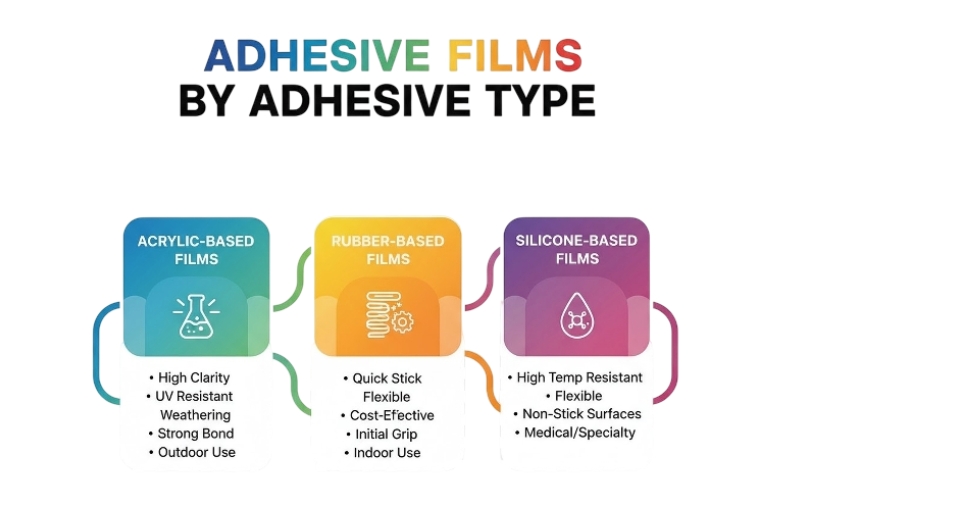
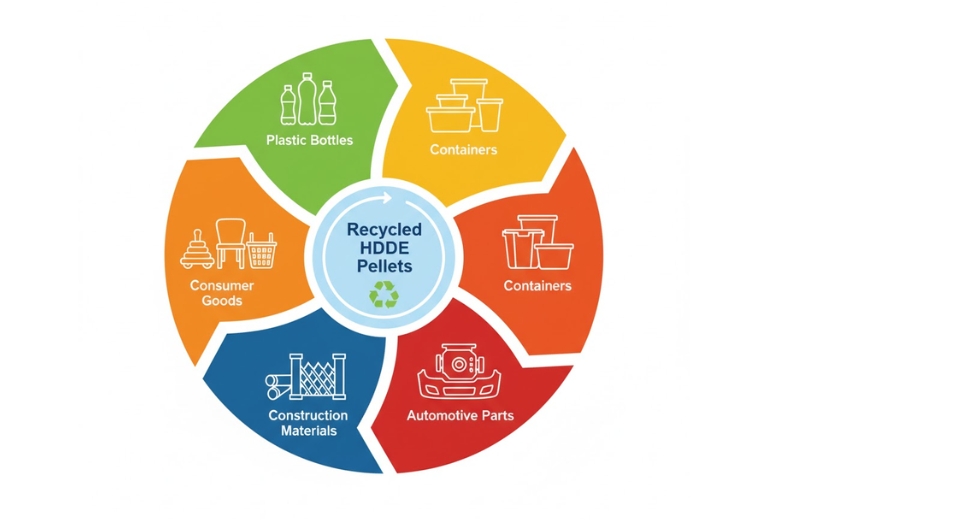
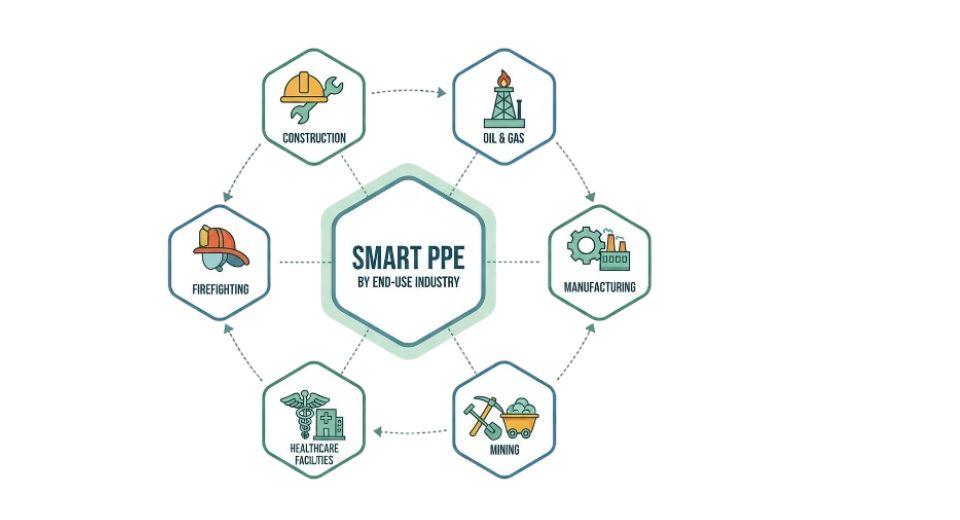
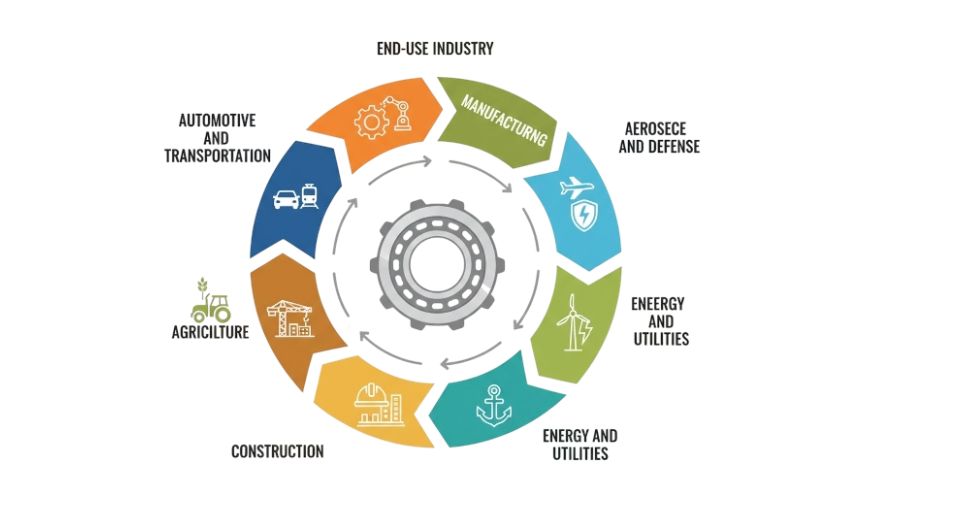

 US: +1 3023308252
US: +1 3023308252






